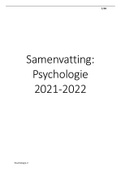Summary
samenvatting 'zes psychologische stromingen en één cliënt' - Bachelor orthopedagogie AP
- Course
- Institution
- Book
Volledige samenvatting met voorbeelden voor verduidelijking en oefeningen na verschillende hoofdstukken Bachelor orthopedagogie (eerste jaar) - AP Vak: psychologie Boek: zes psychologische strominen en één cliënt
[Show more]




